Northern vs Southern Vietnamese food? It is hard to say which is better since they are both incredibly diverse and delicious. In general, Vietnamese cuisine is impressive, from luxury dishes in restaurants to rustic street foods.
Northern and Southern cuisines are two of Vietnam’s main regional cuisines. They do share some similarities but also differentiate from each other. The foods in these two regions have unique characteristics and satisfy all walks of life.
This blog will give you an insight into the features of Northern and Southern Vietnamese cuisine. It will also point out some standout resemblances and contrasts between them. If you don’t want to miss this information, keep scrolling down.
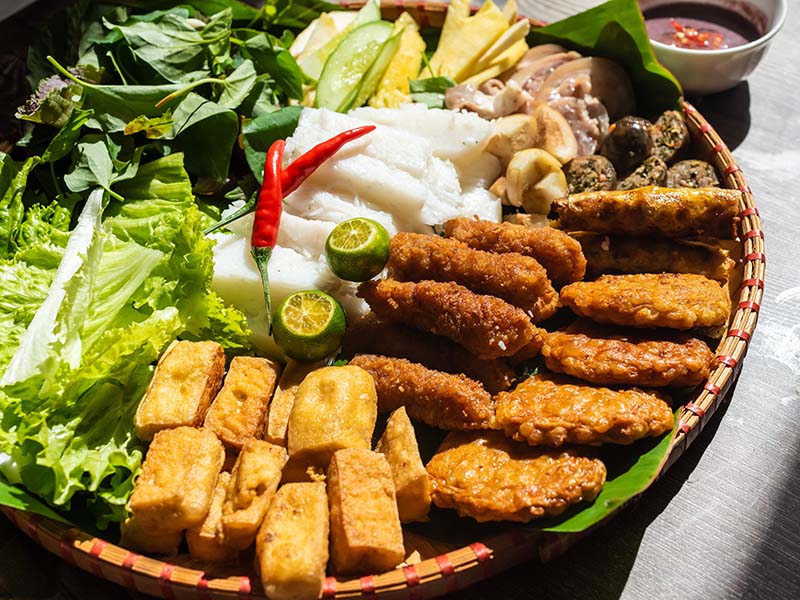
A Brief Summary Of Northern Cuisine
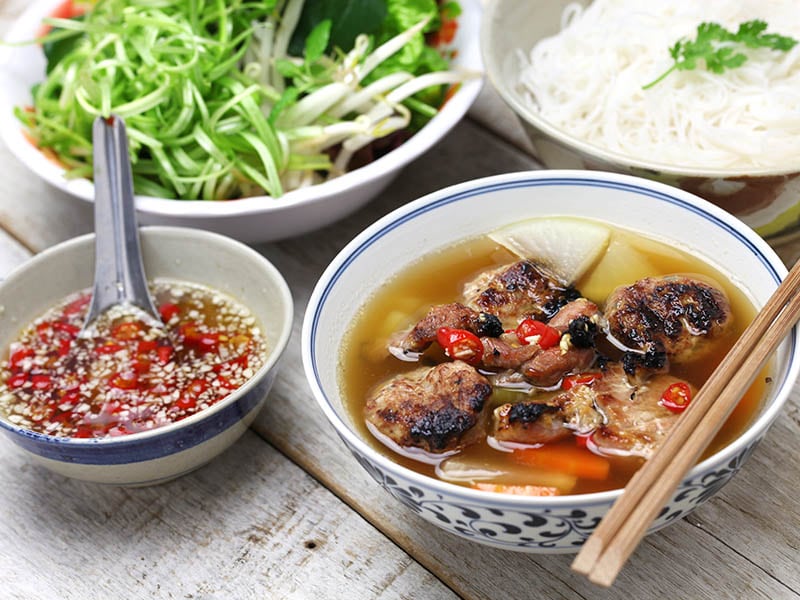
The North is the oldest region in Vietnam with a long-standing history. As you may know, Hanoi – the capital of Vietnam, is located in the North. People consider Hanoi the Capital of thousand years of civilization.
Northern Vietnam consists of three primary regions: the Red River Delta – the most populous one, the Northeast sharing a border with China, and the Northwest adjacent to Laos and China. (1)
The North has many famous destinations, such as Quang Ninh with the wonderful Ha Long Bay and Ninh Binh with Trang An Scenic Landscape Complex. Moreover, this region is famous for the breathtaking Northwest, home to many ethnic minorities in Vietnam.
Northern Vietnam also has colder weather compared to the Central and the South, so ways of using spices and ingredients are also different. All of these historical and geographical features affect and make the Northern cuisine distinctive.
Apart from Phở – the most famous Vietnamese dish, the North is also famous for other traditional dishes, such as Bún Chả (vermicelli with grilled pork), Chả Cá Lã Vọng (turmeric fish with dill and noodles), Thịt Trâu Gác Bếp (buffalo meat hang up in the kitchen).
General Things To Know About Southern Cuisine
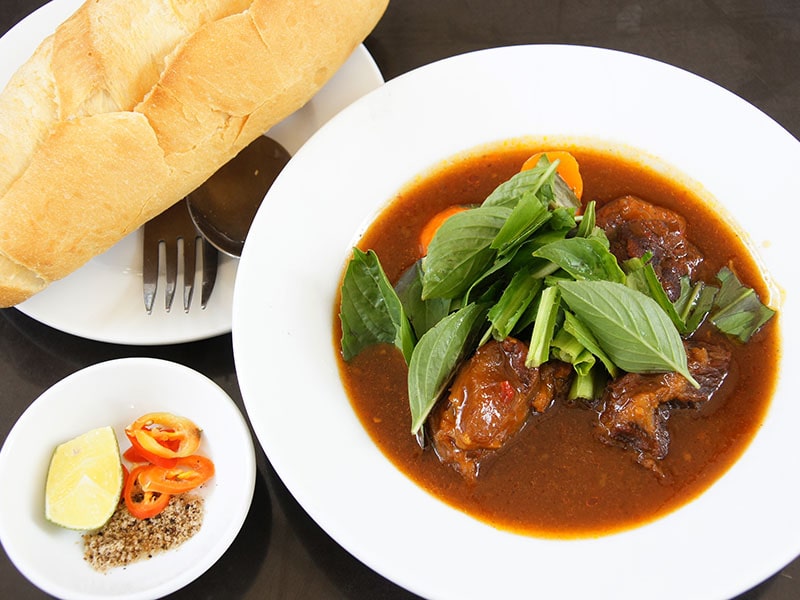
Southern Vietnam includes two main areas: the Southeast region, including Ho Chi Minh City – the biggest city in Vietnam, and the Mekong Delta with many other cities and provinces. Both of them share the same border with Cambodia. (2)
Southern Vietnam is famous for many tourist attractions in Ho Chi Minh City, magnificent Phu Quoc Island, and the unique Cái Răng floating market in Can Tho city in the Mekong Delta area.
Southern Vietnam is a fertile land enriched by a system of interlaced rivers and canals. The weather in the South is warmer than in other parts of Vietnam. Thanks to the natural conditions, Southern Vietnam has diverse and rich products.
This area also has many influences from foreign cuisines, such as Champa and Cambodian cuisine. All of these characteristics contribute to the uniqueness of Southern cuisine.
Bò Kho (beef stew), Hủ Tiếu Nam Vang (shrimp and pork chop noodle), and Bánh Khọt (Vietnamese mini savory pancake) are some iconic Southern dishes.
A Full Comparison Of Northern Vs Southern Vietnamese Food
Now, let’s delve into the detailed characteristics of Northern and Southern cuisine. These two typical regional cuisines are similar in some ways, but they have distinctive features. The table below compares some typical characteristics of Northern and Southern food.
Some Features Shared By Both Northern And Southern Food
Because both of the regions belong to Vietnam, they share some culinary features for certain. The similarities are also some typical characteristics of Vietnamese cuisine. First, let’s look at the fresh ingredients of Northern and Southern cuisine.
Main Staple
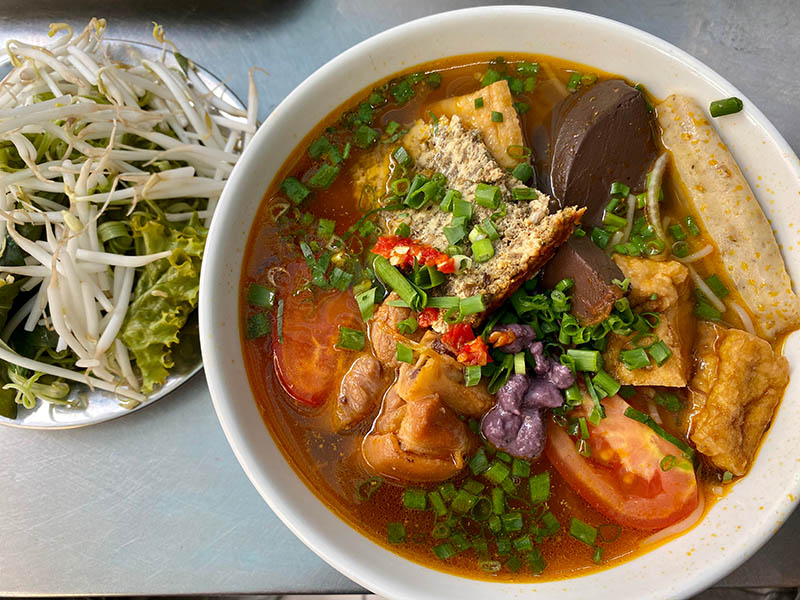
The Red River Delta in the North and the Mekong Delta in the South are two main areas cultivating rice in Vietnam. As a result, rice is the most important staple throughout Vietnam.
From the North to the South, rice appears in the everyday meals of Vietnamese people. They love eating white steamed rice with dishes. Besides, fried rice is also popular in most cities and provinces.
Apart from rice, noodles play an integral part in Vietnamese cuisine. There is a wide variety of Vietnamese noodles of different sizes and shapes. Some typical types of noodles in Vietnam are Bánh Phở, Bún, and Hủ Tiếu. (3)
Bánh Phở is a product of rice flour. The locals create it with white color and flat shape. In addition to the famous Phở, the locals also use this type of noodles to make the stir-fried or rolled versions.
Bún, or Vermicelli, is a rice noodle type with a cylindrical shape and white color. It is a popular ingredient in many Vietnamese dishes, such as Bún Bò Huế (Hue beef noodle soup), Bún Chả (vermicelli with grilled pork), and Bún Riêu Cua (crab paste noodle soup).
Hủ Tiếu is also a product of rice flour, yet it is chewier than Bánh Phở and Bún. The translucent Hủ Tiếu has a smaller size compared to Bánh Phở and Bún. Hủ Tiếu Nam Vang is the iconic dish of this type of noodle.
Besides these types, you can also find different types of noodles like Bánh Canh, Miến, or Cao Lầu noodles. They are made from diverse flours, including rice flour, tapioca flour, wheat, mung beans, or arrowroot starch.
In general, rice and noodles are the two main staples in both Northern and Southern Vietnamese cuisine.
Gordon Ramsay – a famous Chef – enjoyed and experienced selling Vietnamese noodle soups on the floating market in Vietnam.
Main Ingredients
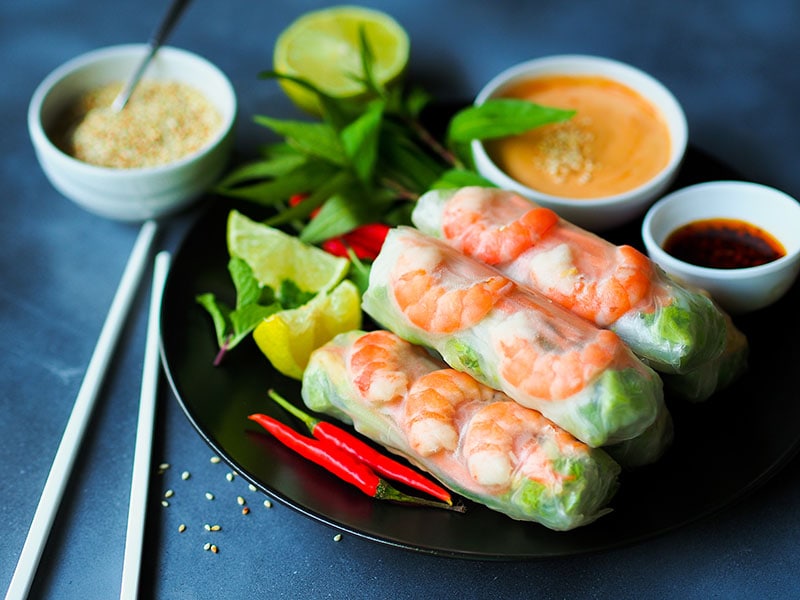
Generally, the main ingredients in Northern and Southern foods are quite similar. The locals use a wide range of meat, from pork and beef to poultry, to create delicious dishes. It is not hard to find meat dishes in both regions.
In addition, as a coastal country, Vietnam is rich in seafood. Fish, shrimp, crab, and squid are important factors in many tasty dishes in Vietnam. The locals also use freshwater species as the main ingredient in many dishes.
Freshness Of Food
The Vietnamese prefer fresh foods in their meals. A common thing in Vietnam among housewives is that they usually purchase foods and ingredients from local markets in the morning to guarantee freshness.
Meat, seafood, vegetables, and herbs, which are the main ingredients in the Northern and Southern dishes, are fresh. As a result, Vietnamese foods normally preserve their original flavors and nutrients.
Herb And Vegetable Consumption
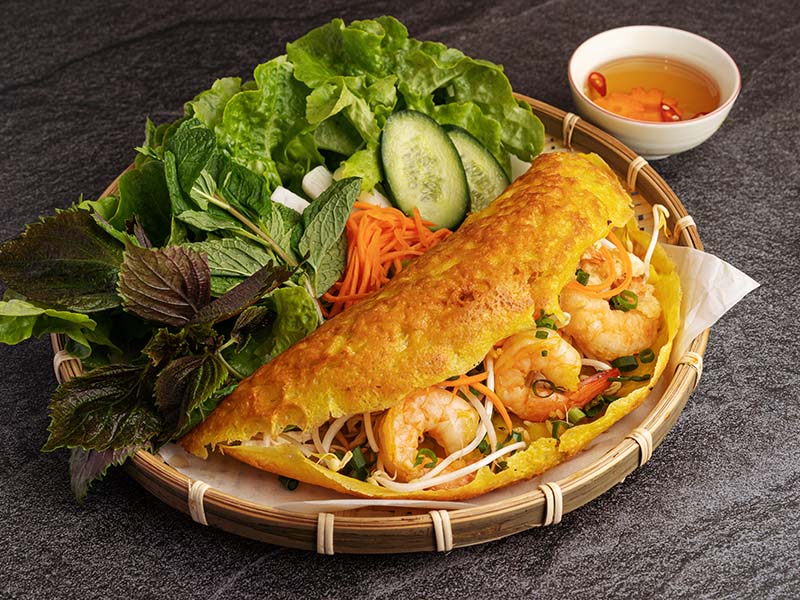
The second similarity, also a typical feature of Vietnamese cuisine, is the preference for herbs and vegetables. You can easily notice that most Vietnamese dishes include rau sống, which means raw vegetables.
The main factors in rau sống are herbs, lettuce, bean sprouts, green banana, shredded banana blossom, and more. Most of them even have therapeutic benefits. The locals usually consume the leaves and buds of the vegetables.
From Northern dishes like Bún Chả (vermicelli with grilled pork), Bún Đậu Mắm Tôm (rice vermicelli with fried tofu and shrimp paste) to Southern dishes like Bánh Xèo (Vietnamese crepe), Gỏi Cuốn (fresh spring rolls), raw vegetables and herbs are essential ingredients.
If they cook vegetables, they mostly boil or stir-fry them with little oil. This is a reason why people consider Vietnamese foods one of the healthiest cuisines in the world.
You will find a large plate of fresh vegetables served with Bún Chả.
Broth And Soup-Based Dishes
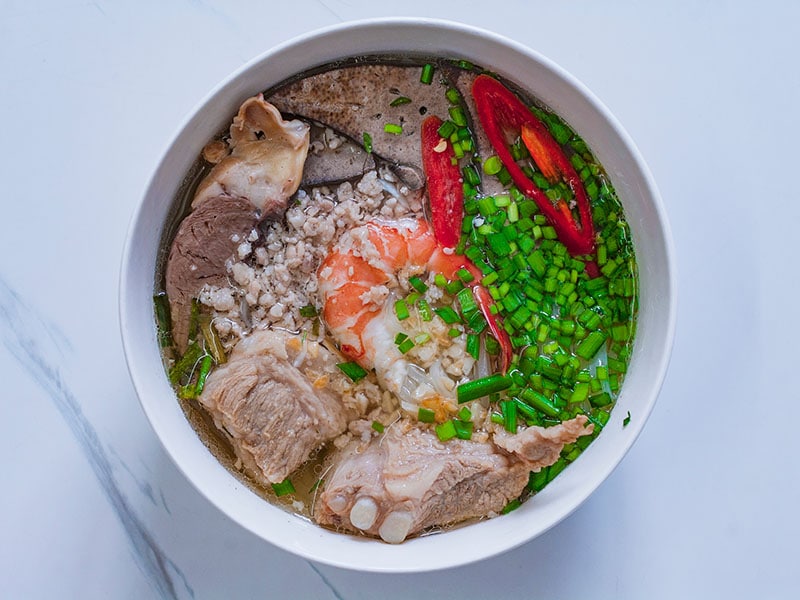
Vietnamese cuisine is famous for many soup-based dishes, such as Phở, Bún Bò Huế (Hue beef noodle soup), and Hủ Tiếu Nam Vang (shrimp and pork chop noodle). It would be a pity if you did not taste these noodle soups.
Despite different recipes for each dish, the soup is the essence of the food. For most dishes, the locals dedicate time to simmering the beef or pork bones to cook the best soup.
On the other hand, the broth, also called canh in Vietnamese, is a common dish in everyday meals of the Vietnamese. They usually pour the broth on the white rice to eat. The ingredients of broths usually are vegetables, meat, and fish.
Typical Vietnamese broths are Canh Rau Ngót Thịt Bằm (katuk broth with minced pork) and Canh Chua Cá Lóc (sour soup with snakehead fish).
Food Presentation

Vietnamese people usually place all of the dishes on a tray, also called mâm in Vietnamese. It helps them carry things all at once. Some families have meals on their dining table, but most households in rural areas place the tray and eat on the floor.
The Vietnamese present plates and bowls of food on the tray in an eye-pleasing way. Meat and vegetables are usually on plates, and broth is in a bowl. Braised fish (Cá Kho Tộ) is in a clay pot in some regions.
Moreover, they also place a small bowl of fish sauce on the tray. Fish sauce is the most popular accompanied sauce in Vietnam and often appears in everyday meals of Vietnamese people. Most people prefer adding some slices of chili to the sauce.
Each person has a bowl of rice to serve with food. When you finish your rice, ask the person sitting near the rice cooker to fill it for you. Chopsticks are the main utensils, while you may see some kids use spoons. They also use ladles to serve broth.
The Vietnamese tray has a round shape which represents fullness and happiness. Dining time is when family members gather and sit around the tray. They tell each other about their day.
The Balance Of Yin And Yang
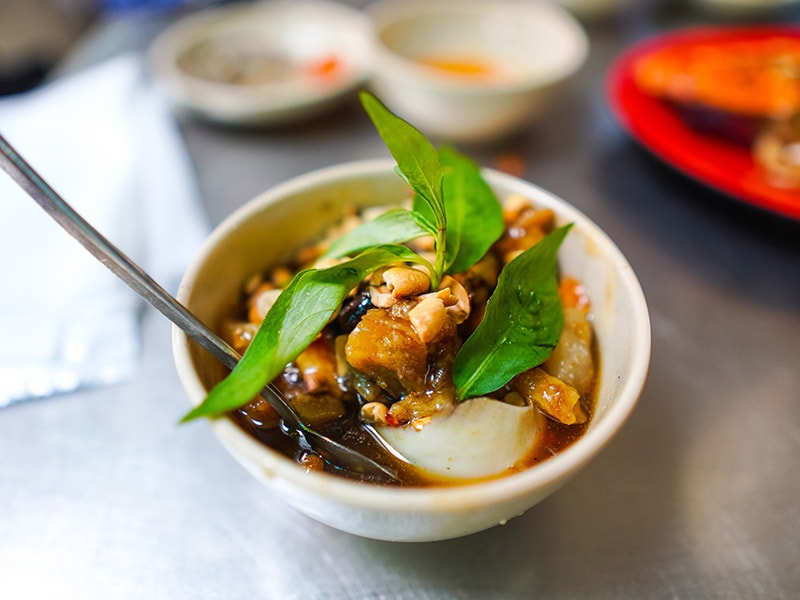
Vietnamese people often place importance on the balance of Yin and Yang in their foods. They believe that the imbalance between Yin and Yang can make humans sick. The “cooling” and “heating” characteristics of ingredients are important.
And ingredients should combine in the right way to create balance. For instance, duck meat is “cool”, so people usually serve it with “warm” ginger fish sauce. Or, balut or baby duck eggs, considered “cold”, must go with “hot” Vietnamese mint.
Table Manners
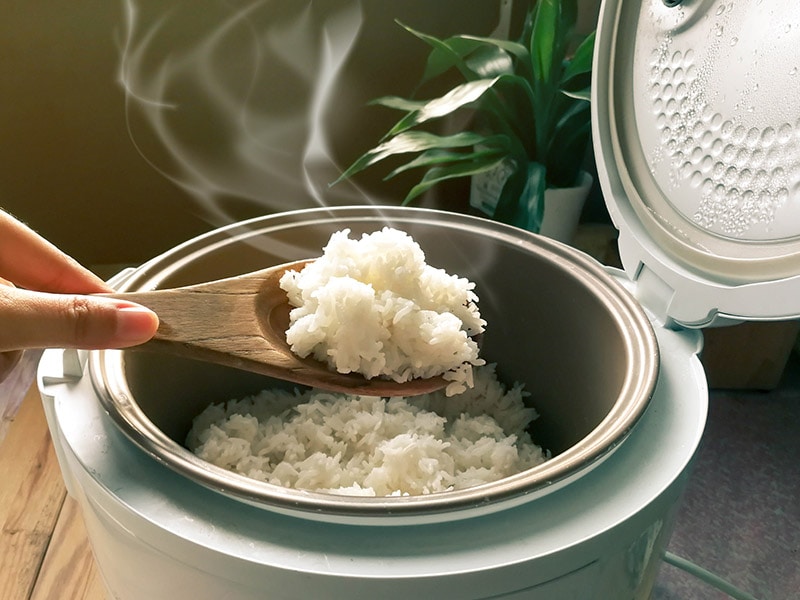
Northern and Southern people share some dining etiquette. Although not every Vietnamese person strictly follows them, they are the typical Vietnamese table manners you should know to avoid offense or misunderstanding.
When you are in charge of the rice cooker, I mean if you sit closest to it, you must help scoop rice for other people. So, remember to scoop more than one because one rice scoop is for dead people.
Second, Vietnamese people avoid eating directly from the serving dishes. Thus, you should not put the food right into your mouth when taking it from the shared plates or bowls. One must put the food in their bowl before eating it.
In Vietnam, it is impolite to start eating before the elderly do. This is one of the behaviors to show respect to the old in Vietnam. So bear in mind that if you have a meal with a Vietnamese family, wait for people older than you to start eating before you do.
There are some table manners about chopsticks you need to pay attention to. First, planting the chopsticks straight up in a bowl of rice is an unlucky behavior. The reason is it resembles the way they burn incense at funerals.
Moreover, do not point into someone’s face with chopsticks since it is an offensive gesture in Vietnam. Another thing you should avoid is passing food by one’s chopsticks from another’s because this may make them have conflicts afterward.
Here are more table manners in Vietnam you should know.
Foreign Influences
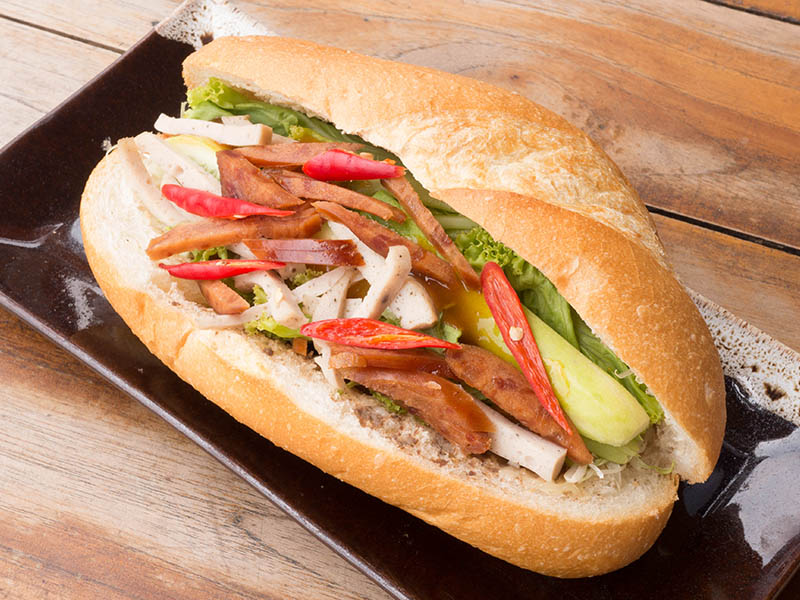
Before I take you to the obvious contrasts, I would like to introduce to you some similar foreign influences between the two regions.
First, the famous Bánh Mì in Vietnam is a French-inspired dish you can find all over Vietnam. From the French baguette, the Vietnamese turn it into Bánh Mì with different types of fillings. CNN has recognized Bánh Mì among the top 23 best sandwiches in the world.
In addition to Bánh Mì, there are more French-inspired dishes in Vietnam, such as pâté, salad, yogurt, beefsteak, and omelet. The French also brought many other ingredients into Vietnam, like onions, asparagus, potatoes, carrots, lettuce, and more.
As a result, the Vietnamese add the word “tây”, which means the West, to denote some vegetables’ origin. You can find khoai tây (potatoes), măng tây (asparagus), and hành tây (onions).
The Vietnamese also adopted some dishes from Eastern Europe, including Russian salad, Czech beer, and stuffed cabbage soup.
What Makes Northern And Southern Vietnamese Foods Different?
Northern and Southern Vietnamese foods have their distinctive features, which make them different from each other. These differences also contribute to the diversity of Vietnamese cuisine. Let’s start with the most typical one, the flavor.
Flavor
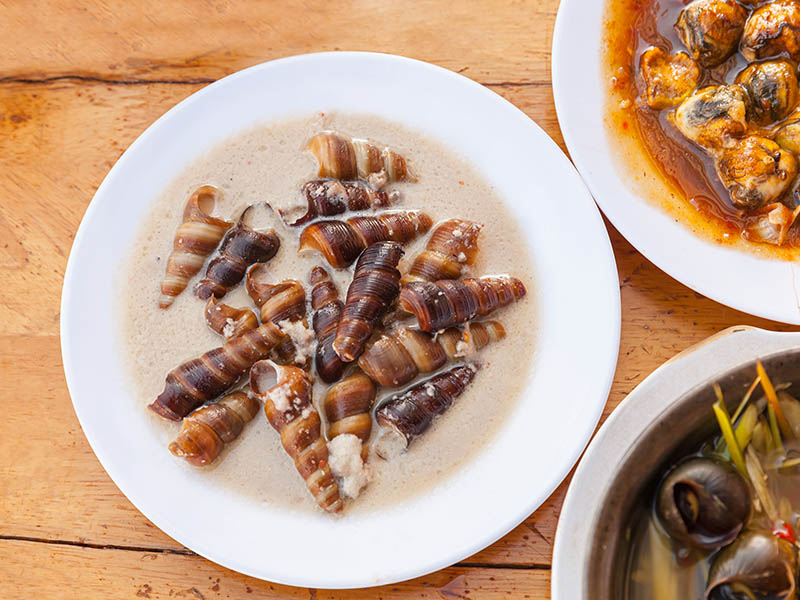
The flavor of Northern foods is savory and mild. Though the foods are a mix of different flavors, none of them is overpowering. Thus, you may find Northern foods not too salty, sweet, sour, spicy, or bitter.
The Northern people combine different spices and ingredients to make sure the food tastes light. Since the dishes have a balanced taste, they are suitable for many people, including foreign visitors.
On the other hand, sweetness is a prominent feature of Southern dishes because the locals prefer adding coconut milk to the food. In the Mekong Delta, the dishes are with a sweet touch of palm sugar.
Besides, Southern foods are more vibrant and flavorful. Since the weather in Southern Vietnam is suitable, there is a wide variety of herbs and spices growing in this land. As a result, the locals tend to use more spices, chili peppers, and herbs in their food.
Foreign Influences

It is not true to say the North and the South do not share any foreign influences. Some culinary features show in both regions. However, there are some external effects that make Northern and Southern cuisines distinctive.
Northern food shows some similarities between Chinese and Vietnamese cuisine. Because the Northern area has the same border as China, it somehow has some influences from Chinese cuisine.
Fried dough sticks, also called Youtiao in Chinese, are indigenous to China. The local people in Northern Vietnam, especially in Hanoi, usually enjoy fried dough sticks with porridge and Phở.
Though fried dough sticks are also available in the South, they still prefer Bánh Mì (bread). And the Southern people rarely eat fried dough sticks with Phở.
Moreover, Thịt Lợn Quay (roasted pork) and Khâu Nhục (braised pork belly) are Chinese-inspired dishes. They are popular food of Tày and Nùng, two ethnic minorities in Lạng Sơn, a mountainous province in Northern Vietnam.
In contrast, Southern Vietnamese cuisine has more influences from Champa, Malaysia, and Cambodia. As I mentioned above, the Southern people prefer using coconut milk in their foods, which is a feature of Cham cuisine.
Besides, since Malaysian traders introduced curries to Vietnam, curry has become a popular dish in Southern Vietnam. The locals usually serve chicken curry on special occasions, such as weddings, funerals, and other social gatherings.
Spices Consumption
Due to the cold weather in the North, the production and spices are much fewer compared to the South, which has warm weather and fertile soil. This characteristic leads to the difference in the use of ingredients.
While the South uses more chilies, Northern people prefer black peppers. Though herbs are present in the foods of both regions, their number is much more in Southern cuisine. Southern people also use more lemongrass, garlic, and shallots in their foods.
Southern cuisine is also famous for wild vegetables. The locals combine some dishes with Bông Điên Điển (common sesban) or Bông Súng (water lily).
Lẩu Cá Linh Bông Điên Điển (hotpot with Linh fish and common sesban) and Lẩu Bông Súng (hot pot with water lilies) are iconic dishes in the South.
How Food Is Served And Traditional Tet Feast

Northern cuisine tends to be sophisticated, while Southern cuisine is more rustic. Northern Vietnam, especially Hanoi, pays more attention to how food is served than Southern Vietnam.
Northern Vietnam is the land of tradition, so there are many customs and traditions in the cuisine they have to follow. In contrast, Southern Vietnam places less emphasis on etiquette than the North. This feature reflects clearly through the traditional Tet feast.
At Tet or Vietnamese New Year, each house should prepare a feast to honor ancestors and pray for a prosperous new year. Each region will have different ways or standards to prepare for the feast.
The feast in Northern Vietnam must include four bowls and four plates (excluding dipping sauce, pickled onions, and sticky rice). They symbolize the four pillars, the four seasons, and the four directions.
The four bowls include Giò Lợn Hầm Măng Lưỡi (stewed pork leg with bamboo shoots), Canh Bóng Thả (traditional pork rind soup), Miến (glass noodle), and Mọc Nấm Thả (Vietnamese pork balls and mushrooms soup).
The foods on four plates are boiled chicken and pork, Giò Lụa (lean pork paste), and Chả Quế (roasted cinnamon pork). Besides, the feast also includes some more dishes like Bánh Chưng (Vietnamese square sticky rice cake) and Dưa Hành (Vietnamese pickled onions).
On the contrary, Southern Vietnamese people do not emphasize detailed rituals. But that does not mean their feast is simple. They also serve the best and most vibrant dishes on the feast.
With the diverse natural products, The South serves many delicious and meaningful dishes at the feast. A typical one is Canh Khổ Qua Nhồi Thịt (Vietnamese stuffed bittermelon soup) with the hope that all of the bitterness and suffering will pass quickly.
Another popular dish in the Southern feast is Thịt Kho Tàu (braised pork and eggs) as a wish for the harmony of the family. And one more traditional dish is Bánh Tét (Vietnamese cylindrical sticky rice cake) with the hope for prosperity.
Beverages
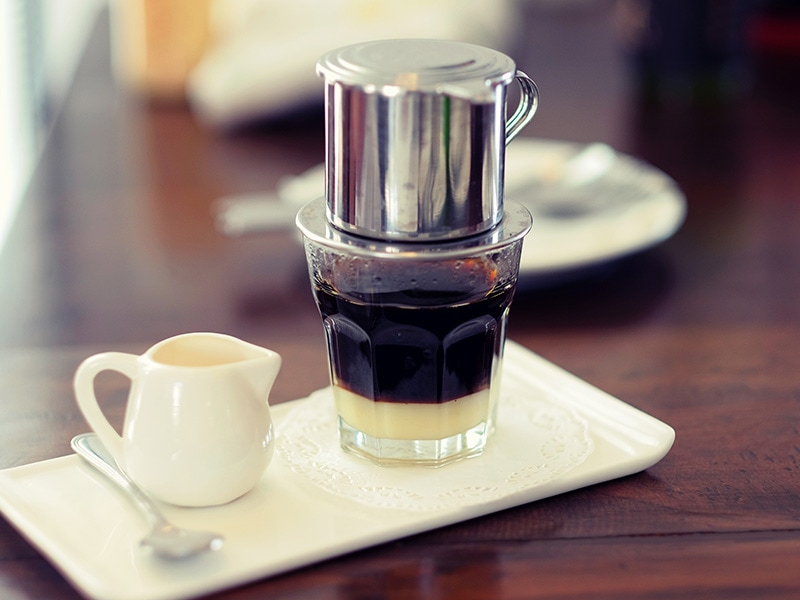
In general, there are many types of Vietnamese beverages, such as tea, coffee, and beer. However, there are some differences between the North and the South in drinking styles and typical beverages.
Southern people prefer a glass of Bạc Xỉu (Vietnamese white coffee) with lots of ice and a not-too-strong coffee taste. Since the Southern weather is hot nearly all year round, they drink coffee to quench their thirst. They also enjoy coffee quite quickly.
Northern people love the stronger coffee taste. Their cups of Vietnamese iced milk coffee have less ice. They tend to enjoy coffee more slowly.
In addition, there are some signature drinks in the North and the South. Northern Vietnam, especially Hanoi, is famous for its egg coffee and Vietnamese lime iced tea. Though they are also available in the South, you should head to the North to taste these authentic drinks.
On the other hand, the typical drinks in the South are Nước Dừa Bến Tre (Ben Tre coconut water) and Nước Sâm Dừa (Vietnamese herbal coconut drinks). Since coconut – one of the most popular fruits in Vietnam – is mainly cultivated in Southern Vietnam, there are more coconut-based drinks there.
Let’s see a traveler trying Egg Coffee in Hanoi for the first time.
Compared To Central Vietnam
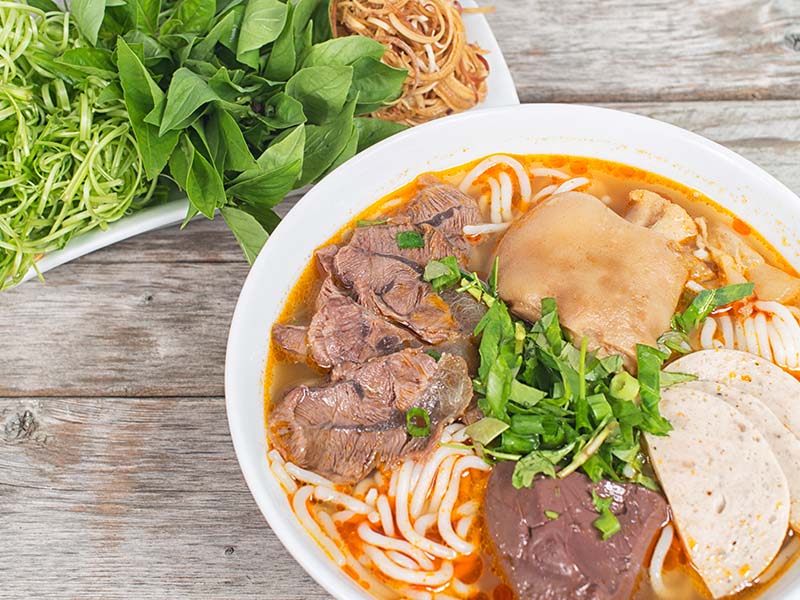
Together with the North and the South, Central Vietnam is also a main culinary region. The Middle of Vietnam does not have fertile soil, and it also usually suffers from tropical cyclones. However, these things do not prevent the locals from creating amazing dishes.
Food in Central Vietnam is the spiciest among the three regions. They usually have a stronger taste compared to food in the North and the South.
Since most of the cities and provinces in Central Vietnam are located near the coastline, seafood is a prominent ingredient in their dishes. The locals also prefer using shrimp paste to boost the flavor of the dishes, especially in Hue.
Some delicious signature dishes in Central Vietnam you should not miss are Bún Bò Huế (Hue beef noodle soup), Mì Quảng (Quang noodle), and Cao Lầu (Cao Lau noodle).
Are These Famous Vietnamese Dishes Similar In The North And The South?
Vietnam is famous for Phở and Bánh Mì (Vietnamese sandwiches), so you may wonder whether they are similar or different in Northern and Southern cuisine. Let me help you find out the answers.
Phở
Phở is the Vietnamese national dish, so you can find it easily everywhere in the country. Though it is a specialty of Hanoi, many people love the version of Phở in Saigon or Ho Chi Minh City. So, here are some differences between the two Phở.
Phở in Hanoi has a subtle taste, and everything in a Phở bowl is well balanced. The noodles have a wide flat shape. The Northern locals usually serve Phở with fried dough sticks.
On the other hand, Phở in the South tastes sweeter. Its noodles have a smaller size. When you order Phở in the South, the locals serve it with a basket of fresh vegetables and herbs and a plate of bean sprouts and lime. Customers can add more to their preferences.
Southern people rarely eat Phở with fried dough sticks. Both versions are delicious the way they are and reflect the features of the regional cuisine.
Here is a full comparison of Phở in Hanoi and Phở in Saigon.
Bánh Mì (Vietnamese Sandwich)
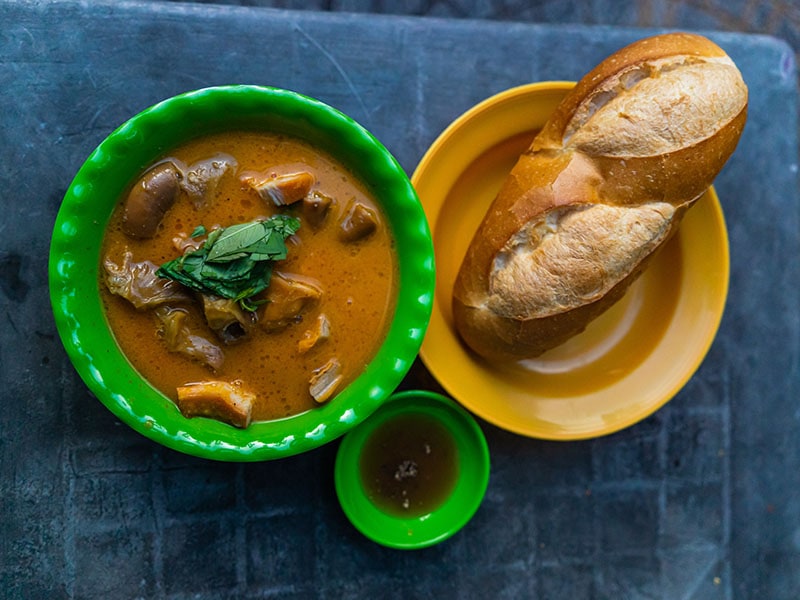
Bánh Mì is one of the most diverse dishes in Vietnam. Depending on the region or the vendor, Bánh Mì can have different sizes, shapes, and tastes.
Bánh Mì is an inspired dish from French Baguette. Because the French first introduced Baguette to Southern Vietnam, Bánh Mì appeared in the South earlier than in the North.
In general, Northern Bánh Mì is not too thick with the crispy outer layer. The fillings in it usually are pâté, salted shredded meat, Giò Lụa (lean pork paste), and coriander.
In Hanoi, there is another popular Bánh Mì version, called Bánh Mì Bít Tết (beefsteak Banh Mi). People serve hot pâté, fried eggs, French fries, and beef on a cast-iron skillet. The customers eat plain bread with those things.
Southern Bánh Mì tends to be bigger and thicker. They usually put grilled pork, fried eggs, Xá Xíu (char siu), and coriander.
The Southern people also combine plain Bánh Mì with Cà Ri (curry) or Phá Lấu (braised beef meat and offal).
Northern Dishes Recipes You Should Try
If you are a fan of Northern dishes, why don’t you try making them at home? Here are some delicious dishes recipes in Northern Vietnam you should not miss.
Bún Chả (Vermicelli With Grilled Pork)
Bún Chả is one of the most famous dishes in Northern Vietnam. This is also the dish that Barack Obama – the former U.S President – enjoyed in Hanoi during his trip to Vietnam. The combination of vermicelli, juicy grilled pork, and fresh vegetables will not let you down.
Phở
You definitely should not miss the Phở – the most internationally recognized dish in Vietnam. A bowl of Phở will be perfect for your breakfast or any other meal. The delicious soup is a real treat to your taste buds.
Bánh Cuốn (Vietnamese Steamed Rice Rolls)
Bánh Cuốn is a must-try dish when you visit Hanoi, so why don’t you show your talent and make this delicious dish at home? The steamed rice rolls with sprinkled fried shallots on top will make your meal more special than ever.
Making Vietnamese Bánh Cuốn (steamed rice rolls) is not difficult, so why don’t you give it a try?
Highly-Recommended Recipes Of Southern Dishes
Now, let’s move to Southern Vietnam. Here are some delicious recipes you can make at home like a pro.
Gỏi Cuốn (Vietnamese Fresh Spring Rolls)
Gỏi Cuốn is one of the healthiest dishes in Vietnam with fresh ingredients. Boiled pork, shrimp, and crunchy vegetables make each roll colorful and taste like heaven. The accompanying sauce is also the essence of the dish.
Bò Kho (Beef Stew)
Bò Kho is another great choice for home-cooked Vietnamese food. You will love the tender beef, carrot, and flavorful soup with herbs. Dip a piece of bread into the soup and put it into your mouth. This combination will not fail to satisfy you.
Bánh Tráng Trộn (Vietnamese Rice Paper Salad)
Bánh Tráng Trộn is a mouthwatering snack in most street vendors in Southern Vietnam. You can totally make it at home for your family. This colorful and flavorful dish will be a perfect choice if you crave a Vietnamese snack.
Bánh Tráng Trộn is a tasty and easy-to-make Vietnamese dish.
FAQs
Learning about the cuisine of a foreign country can be overwhelming. Here are some more questions about Northern and Southern Vietnamese cuisine in case you still feel unsure about some points.
Both Northern And Southern Vietnamese Food Are Worth Trying
At this point, you grasp the key information about these two main culinary regions in Vietnam – the North and the South. Both of them have a wide variety of delicious dishes and distinctive characteristics. It would be a pity not to try any of them.
So, which region sounds more appealing to you? Please share your opinion and experience with Vietnamese cuisine in the comment section. Should you find this article informative, your shares will be appreciated. Thank you!
References
- En.wikipedia.org. 2021. Northern Vietnam – Wikipedia.
- En.wikipedia.org. 2022. Southern Vietnam – Wikipedia.
- En.wikipedia.org. 2022. Vietnamese noodles – Wikipedia.


Truc Tran (Kris)
Expertise
Home Cooking, Meal Planning, Recipe Development, Baking and Pastry, Food Editor, Cooking-video Maker, Asian Food Content Creator, Vietnamese Food Evaluation Expert
Education
Program: Diploma of Hospitality (Commercial Cookery)
Focus: The culinary program included a Certificate III in Commercial Cookery, a Certificate IV in Kitchen Management, and a Diploma of Hospitality Management. This education provided a comprehensive blend of theoretical and practical training in finance, sustainability, diversity, and human resources management.
Program: Culinary Arts at Kendall College (Australia Branch in Sydney)
Focus: Explored global cuisines, and developed entrepreneurial abilities to manage a successful food business, along with acquiring essential language, math, computer, and communication skills for success.
Program: Certificate of Vietnamese Cuisine Head Chef
Focus: Master traditional and modern Vietnamese cooking techniques.
Truc Tran, or Kris, is an accomplished food editor with extensive training in hospitality and culinary arts, including a deep focus on Vietnamese cuisine from various prestigious institutions. She possesses over nine years of experience, developing her expertise in global cuisines and blending traditional Vietnamese cooking with contemporary trends to create engaging and educational content.
She also has a rich educational background, including a Diploma of Hospitality from TasTAFE and a Bachelor of Arts in Culinary Arts from Kendall College’s Sydney branch. It enables her to offer unique insights into meal planning, recipe development, and food culture, making her articles and cooking videos both informative and appealing.